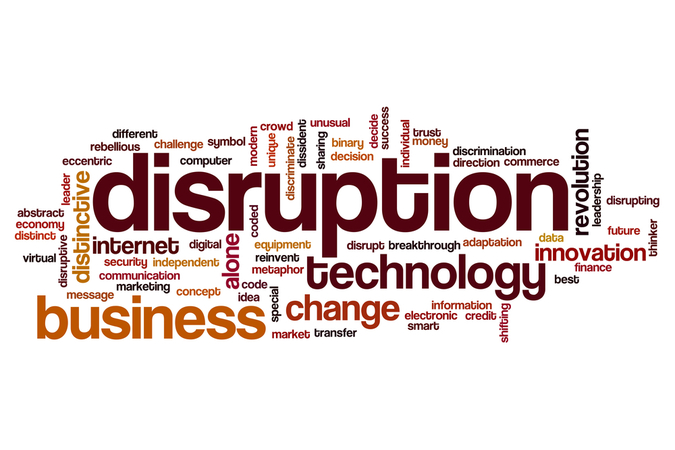If you wired your house with CAT 5 in 2002, you might as well have flushed your money down the drain. Within a year, cheap and easy home wifi was everywhere, making your ethernet cables very expensive insulation. Same goes for your 35” cathode ray tube TV with the custom cabinet you bought in 2007. By 2009, flat screen sizes had increased and prices dropped to the point where you probably had to hire someone to cart off your CRT TV just to get it out of the house – because even if you listed it under Free Stuff on Craigslist, no one would take it.
So, how likely is it that when you look back at that shiny new gas-powered, human-driven Acura you have your sights set on, that you’ll see it as one big paperweight – a large, obsolete technology whose greatest value is as a tax write-off?
The answer: More likely than you think.
Of course, it is easy to know with 20/20 hindsight that wiring your house with CAT 5 in 2002 and buying a CRT TV in 2007 were bad ideas. However, it was also knowable in advance. Predicting technology obsolescence is not only possible, it is vital for every tech company past the start-up phase. At some point, the technology that your product is based on or the market you compete in will get disrupted and it is an event that you need to plan for.
In the simplest case where one technology is a direct substitution, such as flat screen TVs replacing CRTs, modeling technology disruption, the predicted rate of decline of a market, is essentially the inverse of modeling technology adoption. As the sales of the new technology ramp up, there is an equal drop-off in the old technology
For a Direct Substitution, The Disruption Curve is the Inverse of the Adoption Curve
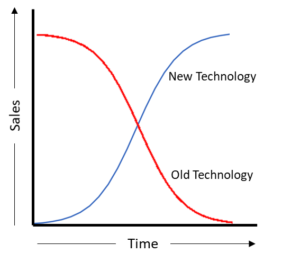
The more complicated cases are ones where the new technology is a partial substitute. In some cases, customers may completely replace the old technology with the new one, while in others, the new and old technologies might be used side by side. In these cases, the substitution rate also needs to be calculated to measure the true risk of disruption.
This is exactly the case with cable/satellite TV (cable) and streaming services. While there are customers who have replaced cable with streaming (cord-cutters) and those who have reduced their cable bill by replacing some of the pay channels with streaming (cord-shavers), there are plenty who have piled streaming services on top of their cable bill. That is why even though Netflix has 55 million subscribers in the US, the number of cable subscribers has only fallen by 7 million from its peak in 2012.
Netflix Subscribers Soared to 55 Million in the US at the End of 2017…
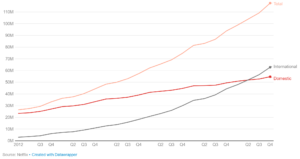
…However, US Cable/Satellite TV Subscriptions Have Only Fallen by 7 Million Since their Peak
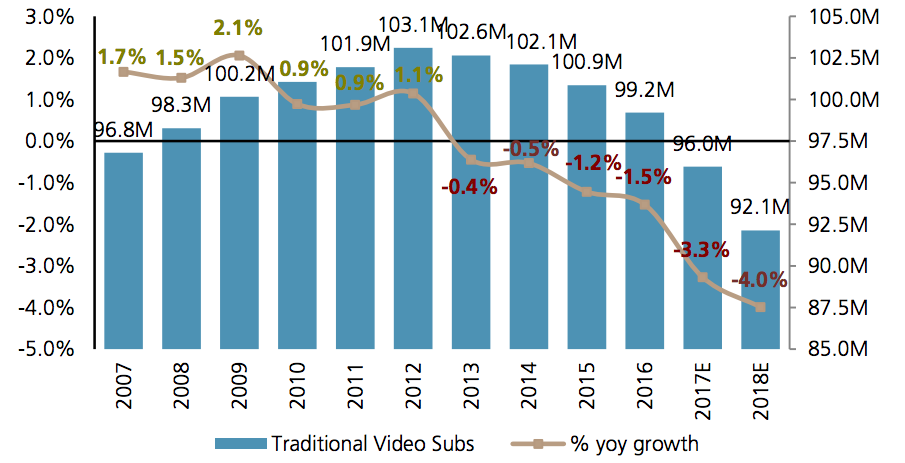
This now brings us back to whether your gas-powered, human-driven Acura will one day be a big paperweight like your 2007 vintage 35” CRT TV. Right now, the traditional automobile is threatened by two emerging technologies: electric cars and self-driving cars.
Electric cars:
Electric cars will be a direct substitution for gas-powered cars. For practically every electric car sold, there will be a gas-powered car that isn’t. According to one of the most aggressive mainstream estimates available from Bloomberg, electric cars will hit price parity on the original purchase price alone (and will be cheaper when lower maintenance and fuel costs are considered) by 2022 and will make up 54% of new car sales by 2040.
However, if you are managing a business based on the sales of new gas-powered cars, it would be prudent to also consider that adoption could be far, far faster. Practically every day, there is an announcement of plans for new electric car models, factories, charging networks and more, which makes it possible that electric cars will move into the majority of new sales within 10 years.
Self-driving cars:
Unlike electric cars, self-driving cars are a partial substitute for new car sales.
While some people will buy their own self-driving cars, most instead will use them as part of a ride share service. Like with Netflix and Cable, many people will replace their car with ride sharing while others will still own their own car AND use self-driving ride shares.
While ride share and car sharing services like Zipcar have had a minimal impact on new car sales to date, self-driving cars would be a game changer. According to Topline analysis based on data from RideSharingDriver and Ridester, the driver represents 53% of the cost of a typical ride. Cutting fares by 53% or potentially even more, as competition among services drives down the per-ride fees the ride share services themselves charge, would make ride sharing a viable alternative to owning a car for an increasing number of people.
Today, the Driver Represents 53% of the Cost of a Typical Ride Share Ride
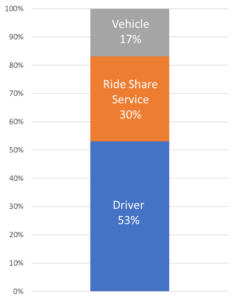
Of course, the big question here is when. While many estimates put the date for true self-driving as still a decade or more away, like with electric cars, the timeline seems to be getting shorter and shorter. In November, Waymo announced that it will be launching a self-driving taxi service in Arizona in 2018 with no human supervisors in the cars at all.
So what does this mean for that gas-powered, human-driven Acura? Will it one day be a paperweight?
Actually, no.
Within the life of a car bought in 2018, there is little risk that it will become unusable. The bigger risk is to the car’s resale value. As car ownership rates drop due to self-driving technology and more electric cars are on the road, the demand for used, gas-powered, human-driven cars will plummet. However, the inflection point on the adoption curve for both of these technologies is probably at best 5 years away, which means that it is likely closer to 10 years before the resale values will really diminish. At that point the car will be largely depreciated anyway.
The real risk will come in about 5 years. In 2023, your new gas-powered, human-driven car may look a lot like a CRT TV bought in 2007.
Again, predicting technology obsolescence is not only possible, it is vital for every tech company past the start-up phase. Seeking insight into future market dynamics and technology trends for your business? Topline Strategy can help. If you would like to learn more contact us.

